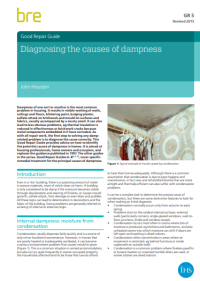Diagnosing the causes of dampness (GR 5 revised)
BRE (Building Research Establishment) is an independent, research-based consultancy, testing and training organisation, operating in the built environment and associated industries.
Diagnosing the causes of dampness (GR 5 revised) was written by John Houston and published by BRE on 18 March 2015.
Even in a ‘dry’ building, there is a surprising amount of water in porous materials, most of which does no harm. A building is only considered to be 'damp' if the moisture or its effects become visible, leading to deterioration in decorations or the fabric of the building.
Dampness is the most common problem in housing. It results in visible wetting of walls, ceilings and floors, blistering paint, bulging plaster, sulfate attack on brickwork and mould growth on surfaces and fabrics, usually accompanied by a musty smell. It can also lead to less obvious problems such as a reduction in the effectiveness of thermal insulation or cracks in brickwork due to the corrosion of embedded metal components.
The first step in solving damp-related problem is to diagnose the cause.
This Good Repair Guide provides advice on how to identify the potential causes of dampness in homes. It is aimed at housing professionals, home owners and occupiers, and replaces guidance published in 1997.
Its contents are:
- Introduction.
- Internal dampness: moisture from condensation.
- External dampness: rain penetration.
- External dampness: rising damp.
- Construction moisture.
- Leaking pipes.
- Leaking roofs.
- Spillage.
- Ground and surface water.
- Contaminating salts.
- Hidden dampness.
- Specialist inspection.
- References.
Other guides in the series, Good Repair Guides 6–8, cover specific remedial treatment for the principal causes of dampness.
[edit] Related articles on Designing Buildings Wiki
- Assessing moisture in porous building materials.
- BRE articles on Designing Buildings Wiki.
- BRE Buzz articles on Designing Buildings Wiki.
- BRE Buzz.
- BREEAM.
- Building damp-free cavity walls.
- Building Research Establishment.
- Condensation.
- Damp in buildings.
- Damp proof membrane.
- Damp proofing.
- Damp-proof course.
- Dew point.
- Dry rot fungus.
- Efflorescence.
- Humidity.
- Interstitial condensation.
- Penetrating damp.
- Rising damp in walls - diagnosis and treatment (DG 245).
- Rising damp.
- Spalling.
- Understanding dampness.
- Wall insulation and moisture risk.
Featured articles and news
One of the most impressive Victorian architects. Book review.
RTPI leader to become new CIOB Chief Executive Officer
Dr Victoria Hills MRTPI, FICE to take over after Caroline Gumble’s departure.
Social and affordable housing, a long term plan for delivery
The “Delivering a Decade of Renewal for Social and Affordable Housing” strategy sets out future path.
A change to adoptive architecture
Effects of global weather warming on architectural detailing, material choice and human interaction.
The proposed publicly owned and backed subsidiary of Homes England, to facilitate new homes.
How big is the problem and what can we do to mitigate the effects?
Overheating guidance and tools for building designers
A number of cool guides to help with the heat.
The UK's Modern Industrial Strategy: A 10 year plan
Previous consultation criticism, current key elements and general support with some persisting reservations.
Building Safety Regulator reforms
New roles, new staff and a new fast track service pave the way for a single construction regulator.
Architectural Technologist CPDs and Communications
CIAT CPD… and how you can do it!
Cooling centres and cool spaces
Managing extreme heat in cities by directing the public to places for heat stress relief and water sources.
Winter gardens: A brief history and warm variations
Extending the season with glass in different forms and terms.
Restoring Great Yarmouth's Winter Gardens
Transforming one of the least sustainable constructions imaginable.
Construction Skills Mission Board launch sector drive
Newly formed government and industry collaboration set strategy for recruiting an additional 100,000 construction workers a year.
New Architects Code comes into effect in September 2025
ARB Architects Code of Conduct and Practice available with ongoing consultation regarding guidance.
Welsh Skills Body (Medr) launches ambitious plan
The new skills body brings together funding and regulation of tertiary education and research for the devolved nation.
Paul Gandy FCIOB announced as next CIOB President
Former Tilbury Douglas CEO takes helm.
























